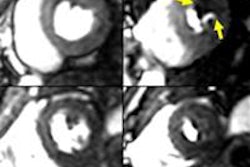Monday, December 2 | 10:30 a.m.-10:40 a.m. | SSC11-01 | Room N226
Japanese researchers have developed a new 3D MR technique that can simultaneously acquire images with and without blood vessel suppression and may help detect brain metastases.The technique is called volume isotropic simultaneous interleaved bright- and black-blood examination (VISIBLE), according to lead author Dr. Kazufumi Kikuchi, from the department of clinical radiology at Kyushu University, and colleagues.
"The most efficient thing is the simultaneous acquisition of both black-blood images and blood-bright images," Kikuchi explained to AuntMinnie.com. "To find a small metastatic lesion, it is incumbent upon enhancing blood vessels. To solve this problem, the black-blood technique was developed, but it causes insufficient suppressed vessel signals, which could mimic lesions. Our technique overcomes these two problems."
Kikuchi and colleagues prospectively imaged 34 patients with suspected brain metastases using both VISIBLE and conventional MPRAGE (magnetization-prepared rapid acquisition with gradient echo). The group consisted of 17 consecutive patients with one to six metastases and 17 individuals with no metastases.
Three radiologists read the MRI results over two sessions. The VISIBLE technique achieved significantly higher sensitivity and significantly shorter reading time than MPRAGE, the researchers found.
"Early, accurate diagnosis of brain metastases is crucial for a patient's prognosis," Kikuchi added. "Our new sequence can find the minimal metastatic lesion precisely so it is useful for the treatment strategy."


.fFmgij6Hin.png?auto=compress%2Cformat&fit=crop&h=100&q=70&w=100)





.fFmgij6Hin.png?auto=compress%2Cformat&fit=crop&h=167&q=70&w=250)











